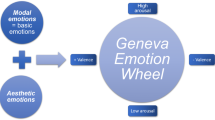Abstract
In this paper, we analyzed the descriptions of learning provided by 234 College of Education students from Finland and Canada and compared them with Whitehead’s (1932/1962) epistemological theory of the rhythm of mental growth. The students were asked to “Give a concrete example of a situation in which you really learned something.” The descriptions of learning provided by the students were analyzed using a constant comparative method. This analysis resulted in the identification of six primary aspects of learning: emotional significance, reflection, differing perspectives, collaboration, autonomy, and dialogue. When examined in the context of student descriptions, the aspects of learning seemed to occur in rhythmic patterns. These findings led us to conclude that Whitehead’s theory of mental growth has merit and could inform new theories of learning that take into account human aesthetic experience.
Similar content being viewed by others
References
Brookfield, S.D. (1994). Using critical incidents to explore learners’ assumptions. In J. Mezirow (Ed.), Fostering critical reflection in adulthood (pp. 177–193). San Francisco: Jossey–Bass.
Bruner, J. (1996). The culture of education. Cambridge, MA: Harvard University Press.
Flanagan, J.C. (1954). The critical incident technique. Psychological Bulletin, 51(4), 327–358.
Flynn, M. (1995). Conflicting views on the importance of emotion to human development and growth: Piaget and Whitehead. Interchange, 26(4), 365–381.
Flynn, M. (2000). A critique of scientism not science per se. Interchange, 31(1), 83–86.
Flynn, M. (2003). Putting the psyche back in psychology. Process Papers, 7, 12–21.
Guba, E.G., & Lincoln, Y.S. (1994). Competing paradigms in qualitative research. In N. Denzin & Y.S. Lincoln (Eds.), Handbook of qualitative research. London: Sage.
Holtzkamph, K. (1991). Was heisst “psychologie vom subjektstandpunkt?” Ueberlegungen zu subjektwissenschaftlicher theoriebildung (What is “psychology from the subject’s point of view?” Reflections on subject–scientific theory building). Forum Kritische Psychologie, 28, 5–19.
Jarvilehto, T. (1998a). The theory of the organism–environment system: I. Description of the theory. Integrative Physiological and Behavioural Science, 33, 317–330.
Jarvilehto, T. (1998b). The theory of the organism–environment system: II. Significance of nervous activity in the organism–environment system. Integrative Physiological and Behavioural Science, 33, 331–338.
Soini, H. (1999). Education students experiences of learning and their conceptions about learning disabilities: Towards a comprehensive theory of learning. Acta Universitatis Ouluensis: Scientiae Rerum Socialium, E (40). Oulu, Finland: Oulu University Press.
Whitehead, A.N. (1962). The aims of education and other essays. London: Ernest Benn. (Original work published 1932)
Whitehead, A.N. (1967). Science and the modern world. New York: Free Press. (Original work published 1925)
Whitehead, A.N. (1978). Process and reality. London: Free Press. (Original published 1929)
Author information
Authors and Affiliations
Corresponding author
Rights and permissions
About this article
Cite this article
Soini, H., Flynn, M. Emotion and Rhythm in Critical Learning Incidents. Interchange 36, 73–83 (2005). https://doi.org/10.1007/s10780-005-2342-2
Issue Date:
DOI: https://doi.org/10.1007/s10780-005-2342-2




